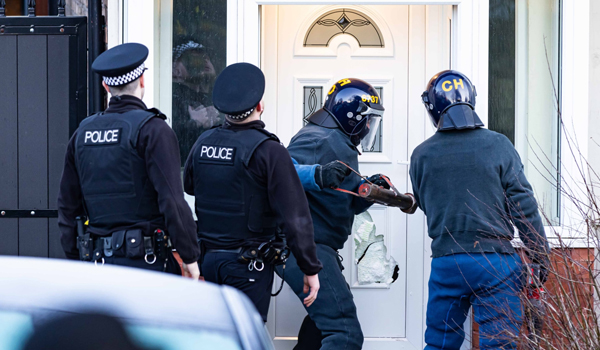County Lines threat remains ‘significant’ and continues to evolve, report finds
County Lines continues to pose “a significant threat to communities” despite stabilising over the past year, according to the latest annual report.
And the annual review of the threat posed by County Lines warned that the business model used by perpetrators “continues to evolve”.
The County Lines Strategic Threat Assessment covering the period from April 2024 to March 2025 found that there are more than 6,500 County Lines in operation across England, Scotland and Wales.
However, it said the rise in internal lines (drug lines operating exclusively in one county) that was evident the previous year, has now stabilised, as has the number of County Lines supplying crack cocaine and heroin – still considered among the most harmful drugs and most closely linked to violence.
The Annual County Lines report, published by the National Police Chiefs’ Council (NPCC) and the National County Lines Coordination Centre (NCLCC), noted that the threat remains stable, with consistent numbers of lines and drug types.
Evidence shows County Lines are a major driver of violent crime, with 73.5 per cent of offenders known for violence or weapons offences.
The report found exploitation of children continues, with 2,659 children recorded, though actual numbers are believed to be higher.
Dedicated policing efforts were impacting the County Lines model, particularly in major exporting areas.
Harm from violence was also decreasing, with a 38 per cent reduction in hospital admissions for under-25s in exporter areas (Metropolitan, Merseyside, West Midlands, Greater Manchester and West Yorkshire – from which a significant proportion of all line types continue to originate).
In addition, the report found that alongside external (traditional County Lines, eg, urban to rural drug distribution) and internal lines (local), there has been a rise in social media lines.
Although heroin and crack cocaine continue to be the predominant drugs exported via external lines, the use of social media and encrypted apps to facilitate drug supply has seen a rise in the distribution of cannabis and so-called party drugs like ketamine, the report said.
It added: “As the social media lines methodology differs to the ‘traditional’ County Lines model it also, notably, lacks the violence and exploitation commonly associated with County Lines, due to its anonymous nature and delivery via the postal network.”
But despite these shifts, the review found exploitation, coercion, intimation and violence remain intrinsic factors of County Lines.
The NPCC says the new child criminal exploitation, cuckooing and coerced internal concealment legislation coming in 2026, will help strengthen the policing response to these crimes and is “much welcomed”.
Boys aged 15-17 are most commonly coerced into drug distribution roles, and the review estimates some 11,600 children – of both sexes and ages – are going missing and are at risk of exploitation. Meanwhile, cuckooing continues to affect vulnerable adults, 44 per cent of whom were women, and many of whom had mental health and/or substance misuse issues.
The NPCC said enforcement efforts have continued throughout the year, with more than 6,000 arrests and a record 2,300 lines closed since July 2024.
During the last County Lines Intensification Week, 96 firearms and 466 bladed weapons were seized, and hospital admissions for sharp object assaults among under-25s had decreased significantly in exporter areas.
The number of children charged during the assessment period has declined, which the NPCC says indicates a shift towards recognising them as victims rather than perpetrators, and a continued concerted effort to work with partner agencies to safeguard those exploited by ruthless criminals.
Commander Paul Brogden, NPCC lead for County Lines and Gangs, said: “It’s clear from this latest report that County Lines continues to pose a significant threat to communities across the UK, though it’s pleasing to see that that threat has remained stable despite the business model constantly evolving and there is evidence that associated harms are reducing, with fewer stabbings in exporter force areas.
“Our County Lines Policing Strategy 2024-27 makes clear how we will continue to respond. It is aligned to HM Government’s mission to take back our streets, particularly their ambitions to reduce serious crime, halve knife crime and go after the gangs who are luring young people into violence and crime.
“By pursuing high-harm County Lines and those controlled by violent drug dealers, we can prevent harm, protect children and vulnerable adults, and disrupt criminal gangs. By working more closely with neighbourhood teams, we can help reduce antisocial behaviour linked to drugs supply and instances of cuckooing, safeguarding vulnerable people.
“Since the formation of the NCLCC we have achieved significant success in combating this harm, particularly through the County Lines Programme which has been identifying and prosecuting the most prolific and dangerous individuals, closing thousands of ‘deal lines’ and disrupting the criminal gangs in England, Wales and Scotland who are responsible.
“We’ve worked hard to identify and refer thousands of at-risk individuals, particularly children, to safeguarding partners for their protection, as well as educating young people and communities to help build resilience.
“However, the threat is constantly evolving, and we must stay vigilant to continue protecting our communities.”
James Simmonds-Read, national programme manager for The Children’s Society’s Prevention programme, added: “The downward trend of children arrested for knife and drug offences associated with County Lines offers hope.
“However, the true scale of this abuse runs far deeper than the numbers show and too many children are still being exploited through County Lines and treated like criminals instead of victims.
“We’re working closely with the NPCC to tackle this exploitation and make sure every child gets the protection and support they need.”


